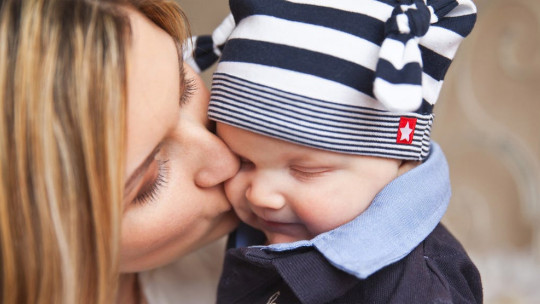
It has been proven that physical contact in childhood is of vital necessity So much so that if this does not occur, the child’s proper development may be affected.
The human baby, compared to other offspring of other species, is more fragile, needing physical and emotional contact with its caregiver in order to survive, grow properly and develop one of the most notable characteristics of human beings, which is to be sociable beings. .
This need for physical contact is already shown in the first moments of life, and direct contact of the newborn with its mother is recommended, body-to-body contact, in order to more easily develop the bond between them, which is so important for the adequate growth of the child. This first physical contact will mark physical contact in later ages.
In this article We will see what drives the child to seek this physical contact, as well as the importance that this has in the correct development of the child and the alterations that may occur if there is not adequate physical contact, if the child’s support figure is not present or is present but in an inadequate way.
Why physical contact in childhood is essential
Physical contact between caregiver and child has been described as both a physical and emotional need, considered a fundamental factor to fulfill the emotional and affective security of the child. Similarly, benefits of physical contact have also been observed in other areas such as motor, cognitive and motor areas.
When carrying out studies focused on the first years of an individual’s life, the period of childhood, it has been proven that the satisfaction of basic needs such as physiological needs, the need to feel protected from dangers, the need to explore, are very important. their environment, the need to play and the need to establish emotional bonds.
In order to adequately satisfy these basic needs, the child’s physical contact with a representative figure will be essential. This need for contact with another individual leads to the emergence of a bond between the infant and the support person, person who tries to satisfy the needs of the child. This link is known in Psychology as attachment.
We can say that the bond leads to the need for physical contact, and physical contact is essential for the bond to continue forming correctly, and thus create a secure attachment. Likewise, emotional needs cannot be satisfied if physical contact does not occur between the child and the attachment figure.
What is attachment?
Attachment is defined as the emotional bond of a person or animal with another of the same species ; This bond drives them to be together in space and time. It is a long process, which begins to develop in the second month of life and lasts throughout life. Although it seems that the most sensitive period, where separation anxiety can occur, is from 6 months to 2 years.
The need for physical contact that the child has during early childhood will cause him to have a tendency to approach the attachment figure and thus maintain physical proximity and communicate with him.
The author who initiated studies on attachment was John Bowlby, who considered it as a control system with biological influence (innate) directed towards a goal and motivated by the need to feel security. That is The attachment figure, for example, the parent, provides a secure base so that the child can move around and explore the external environment
Ainsworth described three types of attachment: secure attachment, the most common and with which the child presents appropriate behavior, seeking contact with the parent and exploring the outside, and two forms of insecure attachment, avoidant or rejecting, the child He is indifferent to the attachment figure and the ambivalent or resistant one, he remains close but at the same time resists contact.
Mention is also made of disorganized attachment, which is a combination of the two insecure attachments, with the child presenting contradictory behavior towards the mother.
It was observed that the mother’s sensitivity to the child’s needs was vitally important Children with secure attachment had kind, receptive mothers who were not annoying and did not mistreat the child, presenting adequate physical and emotional contact.

Studies that demonstrate the importance of physical contact
As we have already noted, Bowlby observed a tendency in young children to seek proximity, physical contact, with a representative figure, a special relationship that the author calls attachment.
Other studies done with primates supported the need for physical contact that young animals had. Harlow and Harlow observed that the main cause for forming the bond, the attachment between chimpanzee babies and their mothers, was not the need to be fed, but the need for warm physical contact with his mother
This fact is confirmed by carrying out a study where they separated the offspring from their attachment figure, and later let them choose between a cold doll that provided them with food or a doll without food but covered in a soft plush. The authors saw that The pups showed a preference for the doll with a warm texture, corroborating the importance of adequate physical contact for the child
Effects of no physical contact on boys and girls
The child is especially vulnerable to separation from the attachment figure, which consequently entails the loss of physical contact with him or her. It has been seen that between the period from 6 months to 2 years this vulnerability intensifies; If the loss of the support figure occurs, it can cause physiological and psychological alterations in the infant These effects are divided into two groups depending on whether they occur in the short or long term.
Short term
The child may present stress, agitation and symptoms of the depressive spectrum Bowlby observed that the evolution of this anxious-depressive clinic develops in three phases.
In the first phase called the protest phase, strong cries and attempts to escape appear in the child. After a period of time, in the phase of ambivalence (or despair), if the attachment figure returns, the child shows disinterest, finally in the adaptation (or detachment) phase, if the conditions are favorable you will be able to develop a new bond.
Long-term
If the child is not able to adapt to the separation and new contacts are not established, It is possible that the child may present intellectual delay, problems in social relationships and may even die
Disorders due to lack of physical contact
As we have already mentioned, the lack of adequate physical contact between the child and the support figure will make the correct appearance of the bond between them difficult, and the appearance of attachment will become more complicated. It has been seen that this alteration in attachment can lead to short-term alterations, some of them already mentioned, as well as disorders in later ages.
Spitz observed that institutionalized children between 6 and 12 months old had previously had a normal relationship with their mother. When this disappears from her, and consequently the child loses physical and emotional contact with her, depending on the duration of this period, the child could show two different conditions
In the first months, after losing contact between 1 and 3 months with the support figure, the child showed crying, withdrawal, weight loss and vulnerability to illness, an alteration that Spitz called anaclitic depression.
If this loss of contact with the protective figure persisted, After 3 or 5 months, the child could develop hospitalism syndrome presenting total passivity, empty facial expression, developmental and intellectual delay or even death, known as death by marasmus.
Attachment-related disorders
In this section we will mention two disorders related to poor attachment, that is, to an alteration of the bond.
In both disorders, The presence of social neglect is a common and essential requirement for these to occur and be considered attachment disorders This neglect is due to an absence of adequate care during childhood, characterized by social abandonment or lack of emotional stimulation, non-satisfaction of physical needs, repeated changes in the support figure, which does not allow bonding or upbringing in places unusual where physical and emotional contact is non-existent or very scarce.
The DSM 5, a diagnostic manual published by the APA, classifies two disorders related to attachment. First of all, reactive attachment disorder presents as an internalizing disorder of depressive symptoms and due to withdrawal behavior, children with this condition show both social and emotional alteration.
On the other hand, disinhibited social relationship disorder as its name indicates, will be characterized by uninhibited behavior and externalizing behavior.








